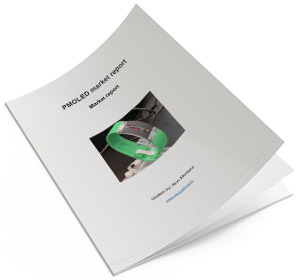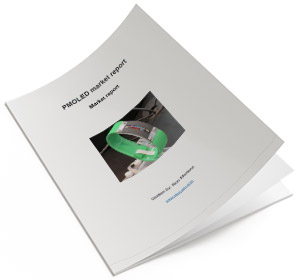OLED displays use organic materials that emit light when electricity is applied. OLEDs enable emissive, bright, thin, flexible and efficient displays. OLEDs are set to replace LCDs in all display applications - from small displays to large TV sets.
PMOLED: Passive Matrix OLED
PMOLED stands for Passive-Matrix OLED, which relates to the way you control (or drive) the display. A PMOLED display uses a simple control scheme in which you control each row (or line) in the display sequentially (one at a time). PMOLED electronics do not contain a storage capacitor and so the pixels in each line are actually off most of the time. To compensate for this you need to use more voltage to make them brighter. If you have 10 lines, for example, you have to make the one line that is on 10 times as bright (the real number is less then 10, but that's the general idea).
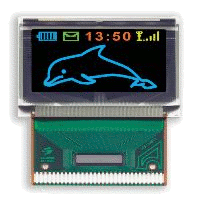 A PMOLED panel by Univision
A PMOLED panel by Univision
So while PMOLEDs are easy (and cheap) to fabricate, they are not efficient and the OLED materials suffer from lower lifetime (due to the high voltage needed). PMOLED displays are also restricted in resolution and size (the more lines you have, the more voltage you have to use). PMOLED displays are usually small (up to 3" typically) and are used to display character data or small icons: they are being used in wearable devices, small gadgets and sub displays
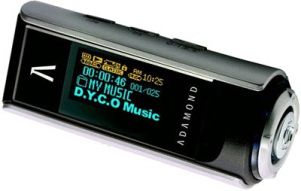
PMOLED vs AMOLED
The other kind of OLED display is called an AMOLED (or Active-Matrix OLED). An AMOLED uses a TFT that contains a storage capacitor which maintains the line pixels lit all the time (even though just one line is changed each time). AMOLEDs consume less power than PMOLEDs, have faster refresh rates and allows to build larger display with higher resolutions. AMOLEDs are also more complicated and expensive to fabricate.
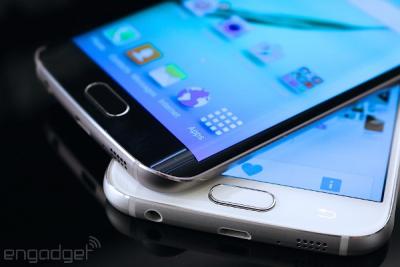
AMOLEDs today are being used as displays for smartphones, digital cameras - and even OLED TVs.
Flexible and transparent PMOLEDs
Some small and simple flexible (conformable) PMOLED displays are already on the market. Japan's Futaba for example is producing several such displays, including a 1.4" 128x16 film PMOLED display adopted in several fitness bands from Garmin, HTC and others.
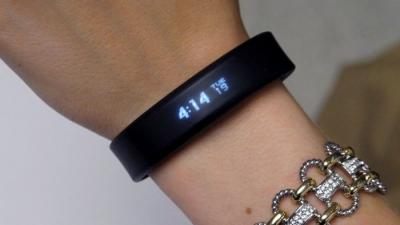
Transparent PMOLEDs are currently in development, with some segmented panels already on the market - but as of early 2018, no dot-matrix transparent PMOLEDs are available.
Looking for PMOLED suppliers?
Are you looking to adopt an PMOLED display for your device? Today there are several PMOLED producers (mostly in China and Taiwan), each making their own kinds of standard and custom PMOLED displays, with a total of dozens of different displays on the market.
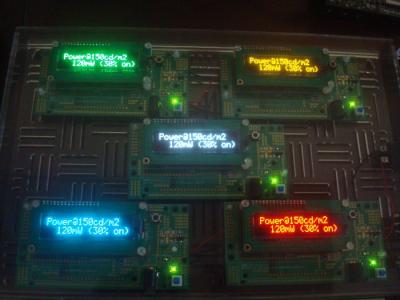
The OLED Marketplace is our very own comprehensive OLED catalog, in which you can find most of the PMOLED displays on the market. Click here to browse our extensive catalog.
The PMOLED Market Report
If you want to fully understand the PMOLED market and industry, check out our PMOLED Market Report. This comprehensive report explains:
- PMOLED production fabs
- Next-generation PMOLED technologies
- Flexible and transparent PMOLEDs
- PMOLED for automotive applications
The report package also provides datasheets and product catalogs and a detailed list of PMOLED producers.
Further reading
The latest PMOLED news:
OLED-Info's flexible, VR/AR, microdisplays, PMOLED, automotive and graphene OLED market reports updated to July 2018
Today we published new versions of our market reports - that cover the flexible, VR/AR, microdisplays, automotive, PMOLED and graphene OLED markets. OLED-Info provides comprehensive niche OLED market reports, and our reports cover everything you need to know about the niche market, and can be useful if you want to understand how the OLED industry works and what this technology can provide for your own industry. The reports are now updated to October 2018.
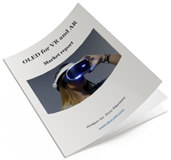 The OLED for VR/AR Market Report:
The OLED for VR/AR Market Report:
- Why OLEDs are adopted in almost all VR HMDs
- What kind of displays are required for VR and AR applications
- What the future holds for the VR and AR markets
- Current and future VR and AR systems
The report package provides a great introduction to the emerging VR and AR market, and details the role that OLED displays will have. Read more here!
Visionox to sell its PMOLED business?
Visionox announced a complex restructuring move, that seems to indicate that the company (which recently reversed-merged with Black Cattle Foods) aims to focus on its AMOLED business and sell its PMOLED business.
The new restructuring, or the PMOLED business sale, involves several China-based companies - including local municipalities, financial investors and even a travel company.
Futaba's flexible 1.8" 160x32 PMOLED display now available on the OLED Marketplace
Futaba launched its flexible (film-type, curvable) 1.8" 160x32 monochrome white PMOLED back in November 2015, and we have now added this interesting panel to our OLED Marketplace.
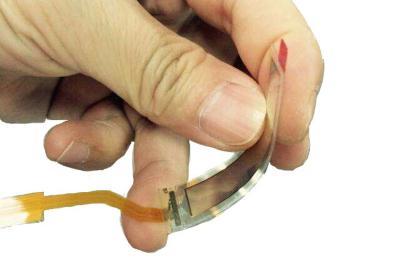
If you are interested in this display for your device or new project, contact us now, or check out more information over at the OLED Marketplace.
Wisechip and Kyulux to bring a flexible TADF/HF PMOLED to the market by the end of 2018
Kyulux and Wisechip unveiled a flexible PMOLED display that uses Kyulux’s Hyperfluoresence yellow emitter. Wisechip says that the power consumption of this display is almost half of Wisechip's regular fluorescent yellow PMOLED.
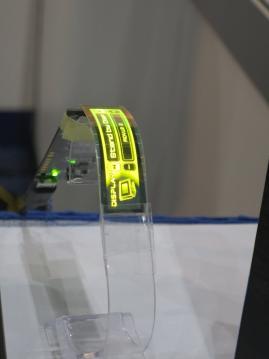
The first flexible HF PMOLED is a 1.71" 256x64 display, that is now ready to be produced (Wisechip says this will enter mass production before the end of 2018). Wisechip originally aimed to introduce its first glass-based HF yellow emitter PMOLED by the end of 2017, but it seems they decided to jump straight to a flexible panel.
Futaba demonstrated its automotive, flexible and transparent PMOLEDs at SID 2018
Japan-based Futaba demonstrated its latest automotive, flexible and transparent PMOLEDs at SID 2018.
We did not see any new displays, but it was great to get an overview of the possible PMOLED solutions that Futaba offers to its target markets (mostly automotive and wearables).
Visionox demonstrates its latest PMOLED and AMOLED displays at SID 2018
China-based OLED producer Visionox had a very impressive booth at SID 2018, demonstrating the company's latest AMOLED and PMOLED displays and prototypes.
Visionox is now producing AMOLED displays for smartphones and wearables and the company showcased a wide range of AMOLED panels and also commercial phones that use these panels. Visionox also demonstrated many new display prototypes.
Visionox demonstrate its first transparent OLED at SID 2018
China PMOLED and AMOLED producer Visionox demonstrated its first transparent OLED at SID Displayweek, a small transparent blue panel (60% transmittance).
The tag next to the display said this was a transparent AMOLED, but it is more likely that it was a PMOLED display - after all it was a simple monochrome blue one. In any case it is great to see Visionox developing transparent displays, in addition to the other next generation technologies it demonstrated at DisplayWeek.
Visionox unveils a blue TASF OLED prototype display
Thermal activation sensitized fluorescence, or TASF, is a new type of TADF OLED emitter material developed at China's Tsinghua University. During SID Displayweek, Visionox demonstrated the first TASF prototype display.
We do not have a lot of information on this new emitter technology, except what Visionox provided at the conference: a sky-blue color (468 nm, CIE: 0.153, 0.201), a luminous efficiency of 26.6 cd/A and an external quantum efficiency of over 17%. The brightness of this OLED PMOLED display was 800 nits.
Lufthansa's upcoming Global 7000 to adopt Bombardier's nice Touch OLED CMS
Lufthansa Technik announced that its upcoming Global 7000 business aircraft will adopt Bombardier's nice Touch cabin management system (CMS). The nice Touch CMS, developed together with Lufthansa, is the first aircraft device to adopt an OLED display.

The nice Touch includes a retractable side-ledge dial (seen above) that allows for rapid control of entertainment and cabin settings. The dial includes a small OLED (probably PMOLED) display. The new system will be on display at the 2018 European Business Aviation Convention & Exhibition in Geneva.
A new OLED-Info market report covers the PMOLED market
We're happy to announce a new market report: the PMOLED Market Report. This report, brought to you by the world's leading OLED experts, is a comprehensive guide to passive matrix OLED displays (PMOLEDs). The PMOLED market is projected to grow rapidly, fueled by demand from wearables and by flexible and transparent displays, but is overlooked by most analysts focused on the (much larger) AMOLED market.
Reading this report, you'll learn all about:
- Applications of PMOLED displays
- Next generation PMOLED technologies
- Flexible and transparent PMOLEDs
- AMOLED vs PMOLED
The report also includes:
- Information on all PMOLED producers
- Current and future PMOLED fabs
- Automotive PMOLEDs
- Display catalogs and datasheets
- Free updates for a year
Pagination
- Previous page
- Page 5
- Next page
